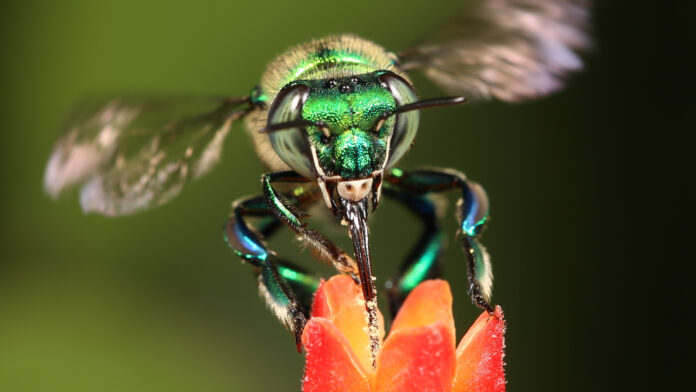Evolution of scent receptor genes distinguishes a divergent species of orchid bee
Orchid bees are master chemists. Each species gathers a unique mix of smells from the environment to attract mates. In a recent study, researchers surveyed two related species of orchid bees, Euglossa dilemma and Euglossa viridissima, and compared their unique perfumes. Even though the two species look identical, they are genetically attuned to their own specific scents.
“This research links the evolution of sexual signaling to a specific gene,” said Philipp Brand, lead author of the study published in Nature Communications and recent Ph.D. graduate from UC Davis, via email. “It is incredibly hard to draw connections like this.”
This study focuses on speciation: the process of a single species diverging into two species. In short, small genetic and behavioral changes accumulate over time to create new organisms. Although speciation happens all the time, it is difficult to pinpoint exactly when one species has split into two distinct lineages.
In the case of orchid bees, Brand hypothesized that the evolution of these perfumes was involved in their divergence. To isolate the small differences that make these bees unique, he needed two model species that were still very similar.
“We focused on trying to find the most recently diverged pair of species of orchid bees we could find,” said Santiago Ramirez, a professor of evolution and ecology.
The two species chosen for the study, E. dilemma and E. viridissima, diverged from each other about 150,000 years ago. This may seem like ancient history, but on the evolutionary time scale, it is as if it happened yesterday.
These two “sister” species of iridescent green bees are virtually indistinguishable — except for their fancy perfumes. Their special scents may play a key role in keeping the two groups of bees from hybridizing back into a single species.
“Male orchid bees collect scents from environmental sources such as flowers, rotten wood and even feces, which they store in pockets in their hindlegs,” Brand said. “These pockets can retain the collected chemicals for weeks and over time the male accumulates a complex chemical blend in them. They eventually release this blend, which we call ‘the perfume,’ during courtship display.”
Male bees spend weeks collecting scents from their environment to impress potential mates. In order for the perfumes to be effective, female bees must be able to sense them.
“They have these structures on their antennae called odorant receptors,” said Micah Freedman, a Ph.D. student in the Ramirez lab. “We think females are attracted to the perfumes that the males collect, and that’s how they recognize males of their own species.”
Through comparing genes for odorant receptors between E. dilemma and E. viridissima, one stood out from the rest: olfactory receptor gene 41 (OR41). To test out how OR41 works, Brand inserted the gene into fruit flies and exposed the flies to different chemical concoctions. The flies with the sensing gene repeatedly picked up on a specific perfume, suggesting that the bee’s unique perfumes are linked to their sensing gene.
“Because we identified the OR41 receptor gene and functionally linked its evolution to the changes in the perfume chemistry, we now have a better idea of the evolutionary history of perfume communication and the genetic mechanisms that are involved,” Brand said.
Making and detecting signature scents drove these bees to split into two completely separate species. Both behavioral changes (mixing scents) and genetic shifts (specialized receptors) reinforce the differences between them.
Curiously, the perfume concoctions for E. dilemma and E. viridissima were identical except for two chemical compounds. Even with this slight difference, the bees detect members of their own species and stay separate from their sister species.
“In this story the speciation of these two particular bees, the compound that really strongly differentiates them — that one bee species collects but the other one doesn’t — we have no idea where they’re getting it,” Freedman said. “That’s part of the fun mystery of this system. As far as we know, no one has found a naturally occurring source of this chemical.”
No matter where the bees find their perfumes, the main difference between E. dilemma and E. viridissima is tied to both mating behavior and genetic shifts.
“The bees don’t seem to care where they get these compounds as long as they get the right combination,” Ramirez said.
The correct compound collection is key to discovering how these bees communicate to members of their own species. The link between chemical collecting and scent detecting reveals how small changes shift populations to become new, separate lineages.
Orchid bees are only a single case study in the larger question of how sexual signaling behavior creates tangible genetic differences between populations of a diverging species. Focusing on chemical differences between these bees provides insight to the molecular level of speciation and the ways these bees start to manifest minute differences.
“The traditional taxonomy and the way that we describe species usually involves studying only the morphological characters that these bees have,” Freedman said. “It’s only through using techniques like studying the chemicals they collect from their environment and their genetics that we actually know how different they really are.”
Written by: Lauren Glevanik — science@theaggie.org





